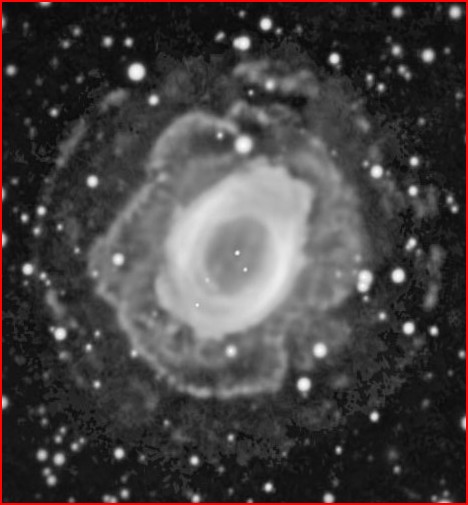
home •
about •
essential guide •
picture of the day •
thunderblogs •
news •
multimedia •
predictions •
products •
get involved •
contact

Credit: The Electronic Universe Project, Nelson Caldwell

Credit: John Smith
pic of the day
archive
subject index
abstract
archive
Links:
Society for
Interdisciplinary
Studies
Sep 01, 2005
A New Theory for the Ring Nebula
New observations of planetary nebulae have falsified old theories, but established theoreticians cling to what they knew despite the availability of more adequate theories.
The Ring Nebula has long been a favorite object of amateur astronomers and has been considered the prototypical planetary nebula. Until recently, the accepted explanation for its appearance, based on the standard theory of stellar structure and evolution, has been that typified by this caption to the April 14, 2005, Astronomy Picture of the Day (APOD):
“The appearance as a ring is really an illusion of projection—the nebula is actually a spherical shell. At the center a blue dot is visible which is the old core of the star, known as a white dwarf. It is still not known exactly how the star throws off the gas that becomes the nebula.”
The instrumentation of the space age trampled that idea into obsolescence. (See “Beyond Dark and Empty” at http://www.kronia.com/thoth/thoVII01.txt ) Clearer and more detailed images from space telescopes, in other-than-optical light, and with electronic sensors have revealed that planetary nebulae have an axial structure that exhibits bipolar symmetry. The accepted explanation is now that typified by this caption to March 22, 2003, APOD:
“This planetary nebula's simple, graceful appearance is thought to be due to perspective—our view from planet Earth looking straight into what is actually a barrel-shaped cloud of gas shrugged off by a dying central star.”
This time the caption neglected to say, “It is still not known exactly how the star throws off the gas that becomes the nebula.” If a spherical ejection was not “exactly” known, the barrel-shaped one is even less “exactly” known.
Although the explanation has changed in response to new observations, the theory is stuck in the mud of institutional astronomy. Theoreticians work to find or to create loopholes in the theory through which they can squeeze the observations rather than admit the theory has been falsified and create another, more accurate, theory. This may ensure job security, but it’s intellectually timid.
Conventional astronomers are at a loss to know “exactly how the star throws off the gas” because neither the nebula nor the star is composed of “gas”. Gas behaves according to the laws of gas kinetics.
But actually the star and nebula are composed of plasma, which behaves according to the laws of electrical discharges and circuits. The star itself is the focus of Birkeland currents that make up a circuit flowing around the galaxy. The electromagnetic “pinch effect” that squeezes plasma into the star also forms the “ring”—actually a toroidal (doughnut-shaped)—current around the star’s equator. The density of the current causes the plasma in the ring to glow. The Electric Universe explanation is that we are looking almost down the axis of an hourglass-shaped plasma structure.
As the Birkeland currents expand away from the pinch, the current density decreases and the glow is less. Modern instruments are sensitive enough to detect this glow, which reveals the structure of the currents feeding the ring: a roughly circular arrangement of bright spots at the ends of dimmer filaments. (The filaments of current continue away from the bright spots; but the plasma density is such that they no longer glow.)
We now know that the prototypical form of planetary nebulae has changed. In response, we need to change the theory that explains it.
EXECUTIVE EDITORS:
David Talbott, Wallace Thornhill
MANAGING EDITOR:
Mel Acheson
CONTRIBUTING EDITORS: Michael Armstrong, Dwardu Cardona, Ev Cochrane,
C.J. Ransom, Don Scott, Rens van der Sluijs, Ian Tresman
WEBMASTER: Michael Armstrong
Copyright 2005: thunderbolts.info